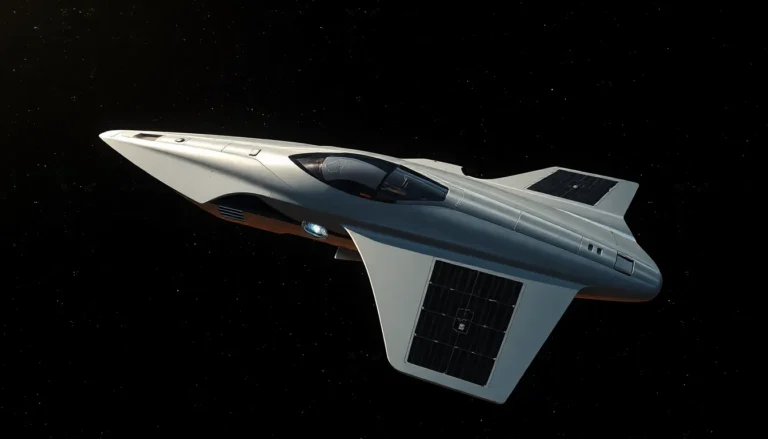Table of Contents
ToggleIn a universe filled with mysteries and cosmic wonders, deep space probes are humanity’s curious little explorers. These high-tech marvels venture into the great unknown, boldly going where no one has gone before—because let’s face it, someone has to check if there are aliens out there binge-watching Earth’s reality shows.
From the icy rings of Saturn to the distant reaches of interstellar space, these robotic adventurers gather data that fuels our imagination and scientific understanding. They’re like the ultimate road trip buddies, except they don’t complain about snacks or ask for bathroom breaks. As we dive into the fascinating world of deep space probes, get ready to discover how they’re pushing the boundaries of our knowledge and maybe even answering the age-old question: Are we alone in the universe?
Overview of Deep Space Probes
Deep space probes represent humanity’s quest for knowledge beyond Earth’s atmosphere. These robotic spacecraft gather essential data from various celestial bodies and phenomena. Missions explore planets, moons, asteroids, and comets, providing insights into their compositions and behaviors.
NASA’s Voyager 1 and Voyager 2 missions exemplify the capabilities of deep space probes. Launched in 1977, they ventured beyond the solar system, transmitting invaluable information about the outer planets and interstellar space. These probes revealed Jupiter’s intense storms and Saturn’s intricate ring structure.
Newer missions continue this trend of exploration. The New Horizons mission, which flew by Pluto in 2015, offered unprecedented views of the dwarf planet and its moons. Meanwhile, the Parker Solar Probe studies the Sun’s outer corona, aiming to uncover the mechanisms behind solar winds and space weather.
Data from these explorations enhances scientific understanding across disciplines. Researchers analyze materials, atmosphere compositions, and magnetic fields, unraveling cosmic mysteries. Probes also test technology for future missions, such as potential crewed explorations of Mars and beyond.
Deep space probes embody the spirit of discovery. They venture into the unknown, capturing humanity’s imagination while seeking answers to fundamental questions about the universe. As technology advances, these missions continue to push the boundaries of exploration, ensuring that our knowledge of the cosmos expands further.
Historical Development of Deep Space Probes
Deep space probes have evolved significantly since their inception, paving the way for groundbreaking discoveries in our universe. Early missions laid the foundation for future exploration.
Pioneer Missions
Pioneer 10 and Pioneer 11 emerged as the first deep space probes. Launched in 1972 and 1973, respectively, these missions marked humanity’s entry into the outer solar system. Pioneer 10 achieved a historic flyby of Jupiter in 1973, gathering data on the planet’s atmosphere and radiation belts. Meanwhile, Pioneer 11 followed suit, providing the first images of Saturn in 1979. Both probes demonstrated innovative technology and strategies for navigation, overcoming the limitations of previous missions. Their success inspired further exploration and expanded scientific curiosity about the outer planets.
Voyager Missions
Voyager 1 and Voyager 2 launched in 1977, building upon the achievements of earlier probes. Voyager 1 conducted groundbreaking studies of Jupiter and Saturn, while Voyager 2 became the only spacecraft to fly by Uranus and Neptune. Data from these missions revealed vital information about planetary atmospheres, magnetic fields, and moons. Voyager 1 now travels in interstellar space, providing insights into the heliosphere’s boundary. With their golden records, these probes also serve as time capsules, showcasing humanity’s culture to potential extraterrestrial life. Collectively, these missions transformed our understanding of the solar system and beyond.
Key Technologies in Deep Space Probes
Deep space probes utilize advanced technologies to explore the universe. Key areas include propulsion systems and communication technologies, which play crucial roles in their missions.
Propulsion Systems
Propulsion systems drive deep space probes toward their destinations. Chemical propulsion remains common in early mission stages, providing thrust to escape Earth’s gravity. Electric propulsion offers increased efficiency for long-duration space travel, using ion or Hall-effect thrusters. Solar sails also come into play, utilizing sunlight pressure for propulsion without relying on fuel. Notably, the Dawn spacecraft employed ion propulsion to reach and orbit Vesta and Ceres, showcasing its effectiveness. These propulsion advancements extend mission lifespans, allowing exploration of distant celestial bodies.
Communication Technologies
Communication technologies enable deep space probes to relay data back to Earth. High-gain antennas primarily handle long-distance signal transmission, ensuring data integrity across vast distances. Deep Space Network (DSN), operated by NASA, supports real-time communication, utilizing large dish antennas to maintain contact. Radio frequencies transmit scientific findings, while advanced coding techniques enhance data compression and error correction. Noteworthy missions like Voyager 1 continue sending valuable data, despite being over 14 billion miles from Earth. Reliable communication technologies ensure that important discoveries reach scientists for further analysis.
Notable Deep Space Probes
Deep space probes play a crucial role in uncovering the mysteries of our universe. They continue to push the boundaries of exploration.
New Horizons
New Horizons, launched in January 2006, achieved a historic flyby of Pluto in July 2015. It provided the first close-up images of Pluto and its moons, revealing surface features and geological activity. Data collected enhanced understanding of Kuiper Belt objects, expanding knowledge of the outer solar system. Following its encounter with Pluto, New Horizons continued to explore other distant objects, including Arrokoth in 2019. Scientists utilize its findings to analyze the formation and evolution of celestial bodies in this region, allowing for deeper insights into the origins of our solar system.
Parker Solar Probe
Parker Solar Probe, launched in August 2018, shows a commitment to studying the Sun like never before. This mission approaches the Sun closer than any other spacecraft, orbiting within 4 million miles of its surface. During its journey, it examines the Sun’s outer atmosphere, or corona, and investigates solar winds. Data from the probe enhances understanding of solar activity and its influence on Earth’s space environment. Each close encounter reveals new information about solar magnetic fields and particle behavior, contributing to advancements in solar physics and improving space weather forecasting capabilities.
Challenges of Deep Space Exploration
Deep space exploration poses significant challenges, ranging from technological limitations to environmental hazards. Extensive distances present communication obstacles, as signals can take hours to reach Earth. Latency in data transmission means scientists often wait long periods for essential information.
Radiation exposure represents another critical issue. High-energy particles in outer space can damage electronic components in probes, risking mission integrity. Effective shielding is necessary, yet it adds weight and complexity to probe design.
Thermal extremes impact probe functionality as well. Temperatures in deep space can vary widely, from freezing cold in shadowed areas to scorching heat when near the Sun. Engineers must account for these conditions to ensure operational reliability throughout a mission.
Longevity becomes a crucial factor during extended missions. Many probes operate on limited power sources, such as radioisotope thermoelectric generators. Managing power consumption becomes essential in ensuring the probe remains functional over decades.
Budget constraints influence mission planning and execution. Funding limitations can impose restrictions on the scope of missions, requiring prioritization of objectives. Each mission must balance ambitious goals with available resources.
Scientific uncertainty also plays a role in mission design. Probes must anticipate unknown conditions and challenges posed by celestial bodies. Increased flexibility in design and operation helps address unexpected findings.
Deep space exploration encompasses multifaceted challenges that require innovative solutions. Handling communication delays, radiation risks, thermal variances, longevity issues, budget constraints, and scientific uncertainties shapes the future of these exploratory missions.
Future of Deep Space Probes
Emerging technologies will significantly shape the future of deep space probes. Advancements in propulsion systems, such as ion drives, promise greater efficiency for long-duration missions. Electric propulsion methods, which allow for continuous thrust over extended periods, can extend mission lifespans, facilitating exploration of distant celestial bodies.
Artificial intelligence plays a crucial role in managing probe operations. Intelligent systems enable real-time decision-making and can adapt to unforeseen circumstances, improving mission outcomes. Probes equipped with AI can analyze data onboard, reducing the amount sent back to Earth and saving valuable communication bandwidth.
International collaboration is becoming increasingly prevalent. Partnerships among space agencies, such as NASA, ESA, and others, enhance resource sharing and foster a collective approach to tackling deep space exploration challenges. Missions like the planned Lunar Gateway will pave the way for future interplanetary endeavors.
Future missions may target exoplanets for potential habitability studies. Probes designed to study these distant worlds can gather atmospheric data and search for signs of life, expanding humanity’s understanding of the universe. Missions focused on the moons of Jupiter, like Europa, could reveal subsurface oceans and the possibility of extraterrestrial organisms.
Sustainable exploration is a priority for future deep space missions. Techniques such as in-situ resource utilization seek to make use of local materials for fuel and life support, minimizing reliance on Earth. This approach will enhance the feasibility of long-term human presence beyond our planet.
Lastly, overcoming significant challenges remains essential. Innovations will be necessary to address issues like radiation protection, thermal management, and communication delays. Developing new materials and technologies will enable probes to survive harsher environmental conditions and extend their operational capabilities.
Conclusion
Deep space probes embody humanity’s relentless pursuit of knowledge and exploration. As they journey into the unknown they not only expand scientific understanding but also inspire future generations. The technological advancements that power these missions are paving the way for even more ambitious endeavors.
From unraveling the mysteries of our solar system to searching for signs of life beyond Earth, each probe contributes to a greater narrative. The challenges ahead will require innovative solutions and global collaboration, ensuring that the quest for discovery continues. As these robotic explorers venture further into the cosmos they remind us of our place in the universe and the endless possibilities that lie beyond.







